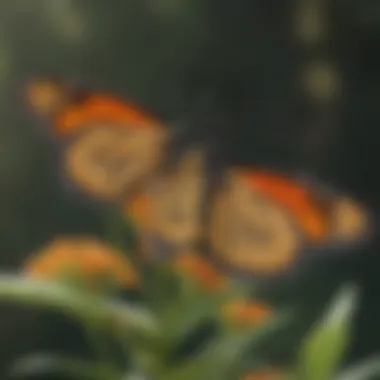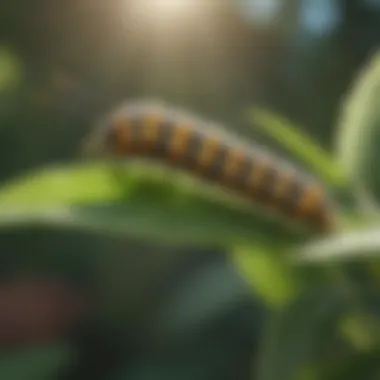Unveiling the Fascinating Monarch Butterfly Habitat: A Detailed Exploration


Overview of the Topic
The monarch butterfly habitat is a complex and vital ecosystem that supports the survival and flourishing of these graceful creatures. Understanding the various elements that make up their habitat is crucial for appreciating the intricacies of their existence. From the specific plants they rely on for sustenance to the environmental conditions needed for successful breeding, every aspect plays a significant role in the monarch butterfly's lifecycle and migratory patterns.
Current Status and Challenges
Currently, the monarch butterfly habitat faces numerous challenges that threaten its stability. Urbanization, pesticide use, and climate change are some of the primary factors contributing to the decline in suitable habitats for these butterflies. Additionally, deforestation and loss of milkweed plants, essential for monarch larvae, further exacerbate the vulnerability of their habitats. Understanding these challenges is essential in devising effective conservation strategies to protect the monarch butterfly ecosystem.
Sustainable Solutions
Implementing sustainable solutions is imperative to counteract the threats posed to the monarch butterfly habitat. Initiatives such as planting native milkweed species, creating butterfly-friendly gardens, and promoting organic farming practices are vital for enhancing the resilience of their habitats. Furthermore, community involvement in habitat restoration projects and conservation efforts plays a pivotal role in ensuring the long-term sustainability of monarch butterfly populations. By adopting eco-friendly practices and prioritizing habitat preservation, we can support the conservation of these magnificent insects.
Impact and Importance
The monarch butterfly habitat not only impacts the survival of these iconic insects but also plays a crucial role in maintaining biodiversity and ecosystem health. Preserving their habitat is essential for preserving the delicate balance of nature and safeguarding the pollination cycle. Furthermore, the cultural significance of monarch butterflies in various communities underscores the importance of protecting their habitats for future generations. By recognizing the value of these habitats and taking proactive conservation measures, we can strive towards a more sustainable coexistence with these remarkable creatures.
Introduction
In the vast realm of biodiversity, the monarch butterfly stands out as a symbol of grace and resilience. Understanding the intricate details of the monarch butterfly habitat is essential to appreciate the environment crucial for the survival of these majestic creatures. This section serves as a gateway into the world of monarch butterflies, highlighting their habitat's significance, diversity, and fragility.
Understanding the Monarch Butterfly Habitat
Key Factors Influencing Habitat Selection
Delving into the monarch butterfly's habitat selection process unveils a fascinating interplay of factors that dictate where these creatures thrive. The key factors influencing habitat selection encompass a delicate balance of environmental conditions, food availability, and safety. Monarch butterflies are particularly drawn to regions abundant in milkweed plants, which serve as their larval food source and breeding grounds. The unique characteristic of these plants as a habitat selection factor lies in their exclusive relationship with monarch butterflies, making them essential for the species' survival. Despite the advantages of milkweed plants in sustaining monarch populations, their decline poses a significant threat to habitat selection, emphasizing the imperative need for conservation efforts in preserving these vital plants.
Importance of Habitat Preservation
The importance of habitat preservation in safeguarding the monarch butterfly's ecosystem cannot be overstated. Preserving suitable habitats ensures the continuity of monarch butterfly populations and sustains essential ecological processes. Habitat preservation plays a crucial role in maintaining biodiversity and mitigating the impact of environmental threats on these delicate creatures. By safeguarding their habitats, conservationists not only protect the monarch butterfly's future but also support the overall health of ecosystems where they reside. The significance of habitat preservation lies in its potential to foster a harmonious coexistence between humans and wildlife, underscoring the need for concerted conservation efforts to safeguard these vital environments.
Monarch Butterfly Habitat Overview
In this section, we delve into the comprehensive overview of the Monarch Butterfly habitat, uncovering the critical elements that shape their environment and influence their survival. Understanding the Monarch Butterfly Habitat Overview is paramount to grasping the intricate dynamics of these majestic creatures. From geographical distribution to climate requirements, every aspect of their habitat plays a vital role in sustaining their populations and fostering their wellbeing.
Geographical Distribution
North America
North America stands out as a pivotal region in the Monarch Butterfly habitat, known for its significant contribution to the overall population of these butterflies. The key characteristic of North America lies in its vast expanse of suitable habitats ranging from Canada to the United States, providing ample resources for the Monarchs to thrive. The unique feature of North America is its diverse landscape, encompassing various ecosystems that support different stages of the Monarch Butterfly's life cycle. While urbanization poses a threat, the conservation efforts in North America have helped maintain crucial Monarch sanctuaries.
Mexico
Mexico plays a crucial role in the Monarch Butterfly habitat, particularly during their migratory journey. The key characteristic of Mexico is its mountainous regions, such as the Sierra Madre Oriental, serving as vital overwintering sites for Monarchs. The unique feature of Mexico is its Oyamel fir forests, where millions of Monarchs gather to survive the winter. While Mexico provides essential habitats, deforestation poses a significant risk to these areas, demanding focused conservation efforts to protect the Monarchs' wintering grounds.
Other Regions


Other regions beyond North America and Mexico also contribute to the Monarch Butterfly habitat, with various countries providing stopover sites and breeding grounds for these migratory insects. The key characteristic of these regions lies in their role as refueling stations for Monarchs during their long journey. The unique feature of these regions is the diversity of flora and fauna that support Monarchs, offering rich nectar sources and breeding sites. While these regions benefit Monarchs, pesticide use and habitat destruction present challenges that require collaborative conservation strategies to ensure the butterflies' steady population.
Climate Requirements
Climate plays a vital role in the Monarch Butterfly habitat, with specific temperature, precipitation, and seasonal variations influencing their survival and behaviors. Understanding the climate requirements is crucial to preserving the delicate balance within the Monarch ecosystem.
Temperature
Temperature serves as a fundamental factor in the Monarch Butterfly habitat, affecting their development and migratory patterns. The key characteristic of temperature lies in its role in triggering different life stages of Monarchs, from breeding to migration. The unique feature of temperature is its impact on Monarchs' metabolic rate, influencing their energy expenditure and movement. While moderate temperatures are favorable, extreme heat or cold can disrupt Monarchs' activities, emphasizing the need for climate-conscious conservation practices.
Precipitation
Precipitation contributes significantly to the Monarch Butterfly habitat, providing essential moisture for plant growth and nectar production. The key characteristic of precipitation is its role in shaping vegetation patterns that sustain Monarchs throughout their life cycle. The unique feature of precipitation is its cyclic nature, influencing Monarchs' breeding cycles and food availability. While adequate precipitation supports healthy habitats, drought conditions can threaten plant diversity and hinder Monarchs' survival, underlining the importance of water conservation efforts.
Seasonal Variations
Seasonal variations have a profound impact on the Monarch Butterfly habitat, dictating migration timings and breeding behaviors. The key characteristic of seasonal variations is their role in signaling Monarchs to initiate specific life stages, such as mating or hibernation. The unique feature of seasonal variations is their cyclic nature, aligning with Monarchs' migratory patterns and resource availability. While seasonal consistency benefits Monarchs, climate change-induced disruptions in seasons pose a significant challenge, requiring adaptive management practices to safeguard the butterflies' habitats.
Vegetation and Plant Species
Vegetation and plant species form the foundation of the Monarch Butterfly habitat, providing essential resources for their sustenance and reproduction. Delving into the specifics of milkweed plants, nectar plants, and host plants offers insight into the plant diversity crucial for supporting Monarch populations.
Milkweed Plants
Milkweed plants play a pivotal role in the Monarch Butterfly habitat, serving as the primary host plant for Monarch larvae. The key characteristic of milkweed plants lies in their toxic properties, which make Monarchs unpalatable to predators, promoting their survival. The unique feature of milkweed plants is their exclusive relationship with Monarchs, as these butterflies rely on milkweed for oviposition and larval development. While milkweed scarcity poses a threat, planting native milkweed species can help restore Monarchs' essential breeding grounds.
Nectar Plants
Nectar plants are essential for adult Monarchs, providing valuable fuel for their energy needs and supporting their long migratory journeys. The key characteristic of nectar plants lies in their diverse floral resources, offering Monarchs a variety of nectar sources for sustenance. The unique feature of nectar plants is their seasonal availability, aligning with Monarchs' foraging behaviors and breeding cycles. While pesticide use can diminish nectar plant populations, promoting pollinator-friendly gardening practices can enhance Monarchs' foraging habitats.
Host Plants
Host plants act as shelters and food sources for Monarch larvae, facilitating their growth and development into adult butterflies. The key characteristic of host plants lies in their compatibility with Monarchs' feeding preferences, ensuring optimal larval nutrition. The unique feature of host plants is their role in providing safe environments for Monarch caterpillars to undergo metamorphosis. While habitat fragmentation threatens host plant populations, creating conservation corridors can enhance Monarchs' access to suitable breeding habitats.
Migration Patterns
Migration patterns play a pivotal role in understanding the movement and behavior of monarch butterflies. The annual journey of these delicate creatures unfolds with precision, guided by environmental cues and instincts honed over generations. By comprehending the intricate dance of northern and southern migrations, researchers and enthusiasts alike gain a deeper appreciation for the remarkable resilience and adaptability of the monarch butterfly population.
Annual Journey
The monarch butterfly's annual journey is a remarkable spectacle that spans thousands of miles, encompassing distinct phases that showcase the butterflies' navigational prowess and endurance.
Northern Migration
Northern migration, characterized by its strategic pursuit of favorable conditions and abundant resources, stands as a testament to the monarch butterfly's quest for sustenance and optimal breeding grounds. This journey offers the butterflies a chance to multiply their numbers and secure their lineage for future generations to come. Despite facing challenges such as fluctuating weather patterns and potential obstacles en route, the monarch butterflies exhibit remarkable fortitude and determination in their northern migration. Their resilience in the face of adversity underscores the importance of conserving critical stopover points and habitats along the migration route.


Southern Migration
In contrast, southern migration represents a period of rejuvenation and rejuvenation for the monarch butterflies as they journey towards warmer climates to escape harsh winter conditions and ensure their survival during the colder months. The decision to embark on this southerly route is guided by the inherent need to seek warmth, shelter, and sustenance in preparation for the upcoming breeding season. While the southern migration offers respite from the challenges of the north, it also presents its own set of risks and uncertainties, underscoring the delicate balance of nature's influence on the monarch butterflies' lifecycle.
Environmental Triggers
Environmental triggers such as temperature changes and day length serve as critical cues that prompt and regulate the monarch butterflies' migration patterns and behaviors. These triggers act as environmental signals that dictate the timing and direction of the butterflies' movements, ensuring synchronization with optimal conditions for feeding, breeding, and survival.
Temperature Changes
The fluctuation in temperature plays a key role in signaling the onset of seasonal transitions and prompting the monarch butterflies to adjust their migratory patterns accordingly. As temperatures shift, the butterflies rely on this cue to determine the ideal timing for migration, ensuring alignment with resource availability and reproductive cycles. While temperature changes can offer valuable insights into the butterflies' adaptive responses to environmental shifts, they also highlight the vulnerability of these creatures to climate variability and human-induced changes that disrupt their natural rhythms.
Day Length
The duration of daylight hours serves as a fundamental trigger for the monarch butterflies, influencing their daily activities, migratory decisions, and physiological processes. The changing length of days acts as a timekeeper for the butterflies, signaling the need to transition between feeding, resting, and migratory phases with precision. By leveraging day length as a cue for gauging seasonal transitions and optimizing their journey timings, the monarch butterflies showcase their remarkable ability to harness environmental cues for survival and reproductive success. The interplay between day length and migratory behaviors underscores the intricate relationship between the monarch butterflies and their surrounding habitat, emphasizing the delicate balance required for their continued existence and well-being.
Breeding and Reproduction
Breeding and Reproduction play a pivotal role in understanding the lifecycle of the majestic Monarch Butterfly. This section sheds light on how these creatures continue their species, highlighting essential aspects of their propagation.
Breeding Grounds
Location Factors
The Location Factors influencing the Monarch Butterfly's selection of breeding grounds are crucial for their survival. These factors include climate, vegetation, and specific features that cater to their needs. The choice of breeding location significantly impacts the success rate of their reproduction. The strategic significance of these locations lies in providing suitable conditions for egg laying and subsequent stages of the Monarch's life cycle.
Population Dynamics
Population Dynamics scrutinize the fluctuation in Monarch Butterfly numbers within breeding grounds. This analysis helps in understanding the trends that affect their population density and distribution. Factors such as food availability and environmental conditions directly influence the sustainability and growth of the Monarch Butterfly population.
Life Cycle Stages
The Life Cycle Stages of the Monarch Butterfly are essential to grasp their evolution from egg to adult. Each stage offers unique insights into their transformation and adaptation within their habitat.
Egg Stage
The Egg Stage marks the beginning of the Monarch Butterfly's life cycle. This phase signifies the foundation of their growth, where optimal conditions are critical for the eggs to hatch successfully. Factors like temperature and humidity directly impact the survival rate of Monarch Butterfly eggs.
Caterpillar Stage
The Caterpillar Stage showcases the Monarch Butterfly's voracious feeding habits as they prepare for their next transformation. This stage is crucial for their development, emphasizing the significance of food sources and shelter in supporting their growth to the next phase.
Chrysalis Stage
During the Chrysalis Stage, the Monarch Butterfly undergoes a remarkable metamorphosis, leading to the formation of their iconic winged form. This stage symbolizes a period of transformation and growth, underscoring the resilience and adaptability of these creatures in their habitat.


Adult Butterfly Stage
The Adult Butterfly Stage represents the culmination of the Monarch's life cycle, where they emerge as fully developed butterflies ready to continue the cycle of breeding and migration. This stage highlights the beauty and grace of these insects, portraying them as vital contributors to their ecosystem.
Threats to the Monarch Butterfly Habitat
Habitat Loss
Habitat loss, particularly through deforestation and urbanization, is a grave threat to the Monarch Butterfly Habitat. Deforestation, the specific practice of clearing forests, eradicates vital food sources and breeding grounds for the monarch butterflies. This rampant destruction of trees disrupts the natural cycle and jeopardizes the sustenance of these majestic creatures. Conversely, urbanization, characterized by the transformation of natural habitats into urban areas, further diminishes the available space for monarch butterflies to flourish. The continuous expansion of cities encroaches upon butterfly habitats, leading to a decline in their population and biodiversity.
Climate Change Impact
The impact of climate change on the Monarch Butterfly Habitat cannot be understated. Global warming effects have resulted in shifts in temperature patterns, disrupting the synchronized interaction between monarch butterflies and their environment. The rising temperatures alter vegetation growth cycles, affecting the availability of nectar and host plants crucial for the survival of monarch butterflies. Additionally, extreme weather events, such as hurricanes and droughts, pose immediate threats to their habitats by destroying essential vegetation and disrupting migration patterns. These unpredictable weather phenomena exacerbate the challenges faced by monarch butterflies already vulnerable to environmental disturbances.
Conservation Efforts
Conservation efforts play a pivotal role in safeguarding the monarch butterfly habitat. In this comprehensive exploration of the monarch butterfly habitat, focusing on conservation efforts is paramount to ensure the preservation of this delicate ecosystem. By delving deep into the specific elements of conservation efforts, we can understand the benefits they bring and the complexities involved in their implementation.
Protective Measures
Monarch Butterfly Reserves
Monarch Butterfly Reserves serve as sanctuaries crucial for the protection and nurturing of monarch butterfly populations. A key characteristic of these reserves is their focus on creating a safe haven for monarch butterflies to breed and thrive, away from threats like deforestation and urbanization. The unique feature of these reserves lies in their ability to provide a controlled environment conducive to the butterflies' development, ensuring their survival. While these reserves offer immense benefits in safeguarding the monarch butterfly habitat, challenges such as limited resources and maintenance issues need to be addressed.
Community Engagement
Community engagement plays a vital role in raising awareness and fostering a sense of responsibility towards conserving the monarch butterfly habitat. The key characteristic of community engagement lies in its ability to mobilize individuals and groups to actively participate in conservation efforts. This engagement is a valuable choice for this article as it highlights the collective responsibility we hold in protecting these creatures and their environment. However, the challenge lies in maintaining long-term engagement and ensuring sustained interest in conservation activities.
Legislative Initiatives
Legislative initiatives are essential in setting the framework for protecting the monarch butterfly habitat at a policy level. The key characteristic of legislative initiatives is their ability to establish legal guidelines for habitat preservation and conservation practices. This choice is beneficial for this article as it emphasizes the importance of governmental intervention in ensuring the long-term survival of monarch butterflies. While legislative initiatives provide a structured approach to conservation, challenges such as enforcement and compliance issues need to be effectively managed.
Collaborative Initiatives
International Partnerships
International partnerships bring together countries and organizations to collectively work towards conserving the monarch butterfly habitat on a global scale. The key characteristic of international partnerships is their ability to pool resources, expertise, and knowledge to tackle habitat preservation challenges effectively. This choice is beneficial for this article as it underscores the interconnected nature of conservation efforts and the importance of global cooperation in protecting these species. However, challenges such as coordination among diverse stakeholders and differing priorities may pose obstacles to seamless partnerships.
Research Programs
Research programs are instrumental in advancing our understanding of the monarch butterfly habitat and implementing evidence-based conservation strategies. The key characteristic of research programs is their emphasis on scientific investigation and data-driven decision-making in habitat conservation. This choice is beneficial for this article as it highlights the critical role of research in informing conservation practices and adapting to environmental changes. Despite the advantages research programs offer, securing funding and ensuring the sustainability of research endeavors remain ongoing challenges that require attention.
Conclusion
Appreciating the Monarch Butterfly Habitat
An Ecosystem Marvel
The monarch butterfly habitat can be viewed as a marvel within the natural world due to its intricate interplay of environmental factors conducive to the sustenance of these delicate beings. One key characteristic of this ecosystem marvel is its diverse array of vegetation, primarily the milkweed plants that act as a primary source for nurturing the monarch butterfly population. The unique feature of milkweed plants lies in their exclusive relationship with monarch butterflies, serving as both a food source and a required component for their reproductive cycle. While this specific aspect of the habitat provides essential sustenance for the monarch butterflies, ensuring their continued existence, it also poses challenges in the face of habitat loss and climate change.
Call to Action
The call to action in appreciating the monarch butterfly habitat revolves around the urgent need for conservation efforts and community engagement to safeguard this vital ecosystem. A key characteristic of this call to action is its emphasis on proactive measures to protect the habitat, such as establishing monarch butterfly reserves and implementing legislative initiatives to preserve their breeding grounds. By highlighting the significance of collaborative initiatives, including international partnerships and research programs, we underscore the importance of collective action in ensuring the long-term sustainability of the monarch butterfly habitat. While this call to action presents a clear path forward for conservationists, students, and environmentalists, it also underscores the challenges posed by habitat loss and climate change, necessitating immediate attention for the preservation of this fragile ecosystem.



